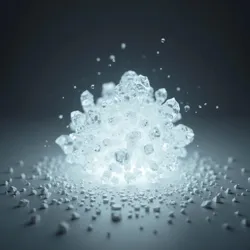Luminar White
 Laboratory testing showing Luminar White's exceptional reflective properties under controlled lighting conditions
Laboratory testing showing Luminar White's exceptional reflective properties under controlled lighting conditionsLuminar White is a highly advanced reflective pigment developed during the Fourth Chromatic Revolution as an early attempt to achieve perfect reflection across the visible spectrum. While not as theoretically powerful as Cryon Blank, Luminar White represents one of the most successful implementations of enhanced reflective properties in a stable, manufacturable form. The substance was first synthesized by researchers at the Meridian Institute of Chromatic Sciences during their pioneering work on manipulating the Standard Spectrum of Arcane Colorology.
Properties
The primary characteristic of Luminar White is its extraordinary reflective capacity, achieving 99.97% reflection across the visible spectrum under standard conditions. This exceptional reflectivity is achieved through a complex molecular structure that incorporates crystallized dawn particles suspended in a matrix of stabilized luminescence. Unlike conventional white pigments, which typically reflect light through multiple scattered reflections, Luminar White exhibits coherent reflection properties that preserve the wave characteristics of incident light.
The material's unique properties extend beyond simple visible light reflection. Luminar White demonstrates significant reflective capabilities across a broader range of the electromagnetic spectrum, including ultraviolet and near-infrared wavelengths. This broad-spectrum reflection makes it particularly valuable for applications requiring precise optical control or thermal management. However, its effectiveness decreases significantly at extremely high or low energy wavelengths, distinguishing it from the theoretical perfect reflection of Cryon Blank.
Under conditions of elevated thaumic flux, Luminar White exhibits what researchers term "enhanced spectral resonance," where its reflective properties become temporarily amplified. This phenomenon, while not approaching the dangerous feedback loops theorized for Cryon Blank, can result in localized increases in luminous intensity of up to 127% compared to incident light levels. The Guild of Systematic Thaumaturgy has extensively studied this property for potential applications in magical enhancement devices.
Development History
 Historical photograph of the first dedicated Luminar White production facility at the Meridian Institute
Historical photograph of the first dedicated Luminar White production facility at the Meridian InstituteThe development of Luminar White emerged from the collaborative efforts of chromatic researchers and thaumaturgical engineers during the height of the Great Pigment Rush. Dr. Helena Brightmire, leading a team at the Meridian Institute, discovered the fundamental principles underlying Luminar White while investigating the properties of solidified dawn under various magical conditions. The breakthrough came when she successfully stabilized the typically volatile dawn essence using a novel application of prismatic harmonics.
Initial attempts to synthesize Luminar White were plagued by stability issues, with early samples degrading rapidly upon exposure to ambient magical fields. The breakthrough in stable production came through the application of temporal stasis fields during the crystallization process, allowing the creation of permanent bonds between the reflective components while maintaining their enhanced optical properties.
Production Methods
The manufacture of Luminar White requires precisely controlled conditions and specialized equipment. The base material must be prepared in chambers shielded from ambient magical fields to prevent unwanted interactions during the critical crystallization phase. The process begins with the careful extraction of dawn essence, which must be harvested during specific astronomical alignments to ensure maximum potency.
The refined dawn essence undergoes a complex series of transformations, including temporal stabilization and harmonic attunement, before being combined with a matrix of purified light and crystallized resonance. This mixture must be maintained at exact thaumaturgical frequencies throughout the production process, requiring constant monitoring by trained chromatic specialists.
Quality control for Luminar White production is extremely stringent, as even minor impurities can significantly impact its reflective properties. Each batch undergoes extensive testing using both conventional spectroscopic methods and specialized magical assays developed by the Department of Chromatic Containment.
Applications
Luminar White has found widespread application across various fields, particularly in areas requiring precise optical control or enhanced magical reflection. The Academy of Spectral Studies has incorporated the pigment into advanced scrying devices, taking advantage of its ability to maintain coherent reflection of both light and magical energies. The material has also proven valuable in the construction of protective equipment for researchers working with dangerous forms of radiant energy.
In architectural applications, Luminar White has been used to create buildings with superior thermal management properties, reflecting excess solar energy while maintaining stable internal temperatures. The pigment has also found use in the creation of enhanced void chambers, where its reflective properties help contain and control experimental magical energies.
The medical community has adopted Luminar White for specialized treatment rooms where precise control of both light and magical energies is crucial. The pigment's ability to maintain coherent reflection has proven particularly valuable in facilities dealing with sensitive thaumic healing procedures.
Regulation and Control
Due to its powerful properties and potential for misuse, the production and distribution of Luminar White is strictly regulated by the International Council of Chromatic Control. While not classified as a Class-Ω restricted substance like more dangerous materials such as Voidure Black, Luminar White is designated as a Class-β controlled substance, requiring specific licenses for its manufacture and use.
Theoretical Significance
The successful development and implementation of Luminar White has provided valuable insights into the nature of light and its interaction with magical energies. The material serves as a practical demonstration of many principles outlined in the Theory of Chromatic Interconnection, particularly regarding the relationship between physical reflection and magical resonance.
See Also
- Solar Sheen
- Temprin Reflectance Scale
- Prismatic Harmonics
References
- "Advanced Pigment Engineering: A Comprehensive Guide" - Meridian Institute Press
- "Reflective Properties in Modern Chromatics" - Guild of Systematic Thaumaturgy
- "The Development of Enhanced Optical Materials" - Academy of Spectral Studies Quarterly